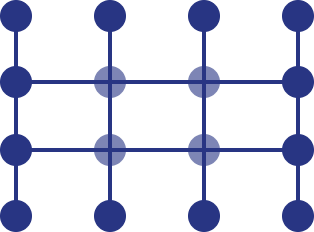DESIGNING BUILDINGS AND FACADES INDIVIDUALLY
Facade greening
Use a facade greening to upgrade and individually design the facades of your buildings through various creepers, tendrils and twiners.
DECO LINE from BRUGG Lifting provides you with the products necessary in the façade greening to offer your plants a safe hold: spacers, cross clamps, climbing rungs and wire ropes made of stainless steel. Fulfill your personal design wish and just combine different elements of DECO LINE with parts from FINE LINE, DO IT LINE or STANDARD LINE.

FUNCTIONS
Advantages of facade greening
A facade greening does something good both for yourself and the planted building. You can benefit from different advantages.
Good indoor climate
Facade greenings have an insulating effect which helps to avoid extreme variations in temperature inside the building. Thus, a pleasant room climate can be achieved in a natural way.
Facade protection
Planting the facade protects it from sun and rain, thus increasing its lifetime.
Attractive appearance
Green facades are simply beautiful! The combination of living green and architecture offers a wealth of charming design options. Together with architects and garden designers, the specialists from Brugg have already realized numerous attractive solutions.
Creating green spaces
In many places ground is scarce and expensive. A green dress for houses opens up the possibility to create additional green space at a favorable price. These micro-gardens raise the quality of our lives.
Steps towards a perfect facade greening
A perfect facade greening requires some steps of planning, design and plant selection.
Planning and Design
When planning a construction for climbers, you need to consider the following weights and forces:
Depending on species, growth and care, the plant’s weight can range from between 1 and 50 kg/m2.
The wire ropes, spacers, climbing rungs and cross clamps included in the architectural rope program from Brugg provide simple, lightweight and yet sturdy fixtures for your climbing plants.
Furthermore, wind pressure, cross wind and wind suction must be taken into account. For this reason, expect an estimated impact pressure of 0.5 kN/m2 for a climber construction of up to 8 meters. For a height between 8 and 20 meters, the pressure would be approx. 0.8 kN/m2 and approx. 1.1 kN/m2 beyond 20 meters. In addition, the fixing devices must take up cross wind forces and tensile loads caused by wind pull.
Another important factor is the tension forces of the ropes which must never be neglected. If, for instance, the entire vertical load is taken up at the top and the bottom, the upper fixture must take up the entire vertical load plus half of the wind load, whereas its lower counterpart only has to deal with half of the wind load. So always be sure to include a sufficient load reserve in your plans!
It should be noted that snow, rain and dew will put a considerable extra load on a planted scaffold. When planning a scaffold structure as a climbing aid, you should therefore calculate with the double or even triple value of the plant’s weight to maximize the life of your façade greening.
Rope configurator for your façade greening
Our rope configurator enables you, easily and intuitively in a few steps, to assemble wire ropes, spacers, climbing rungs and cross clamps for your façade greening and to complement these parts with elements from FINE LINE, STANDARD LINE and MID LINE.

vertical

horizontal and vertical

horizontal
Plants for facade greening
Design your façade according to your ideas by an individual plant selection. The following species are suitable for façade greening.

Twiners such as glycinia, honeysuckles, celastrus, pharbitis and hop wrap themselves around their climbing aids. In the first place, they need vertical climbing aids. With stainless steel ropes, nice and inexpensive solutions may be realized.

The family of the vitaceae comprises creepers like genuine vines, ampelopsis, cucumbers and passifloraceae. Similar to the ranunculaceae, they thrive best on web- or trellis-like creeping aids, which can be designed as long-lasting, attractive objects using stainless steel ropes, rope cross clamps and spacing pieces.

Ranunculaceae such as nasturtium and clematis clasp their climbing aids and therefore need trellis- or web-like constructions. For this purpose, stainless steel ropes are well suited in combination with spacing pieces and rope cross clamps.

Rambling roses, jasminum nudiflorum and other spreading climbers grow and cling with their bristles, spines and lateral offshoots. They find a perfect climbing aid in horizontal rope constructions made of stainless steel.

Parthenocissus (wild wine) is the most widespread adhesive climber in our latitudes. It actually does not need any climbing aid, since it can cling even to very smooth surfaces thanks to its anchoring feet. Thereby, however, adhesive climbers can cause facade damage.

Root climbers such as ivy, euonymus, hydrangea and campsis hold themselves with their air roots and do not need any climbing aid. Just like adhesive climbers, these plants can easily cause facade damage.

BRUGG Lifting is a new member of the Federal Association for Green Building in Germany. The Federal Association for Green Building e. V. (BuGG) is the exciting result of the merger of two long-established associations: the German Roof Gardener Association e. V. (DDV) and the Specialist Association for Building Greening e. V. (FBB). This merger avoids duplication of efforts, consolidates strengths, and enhances BuGG’s impact as a professional association and advocate for building greening in all its forms.